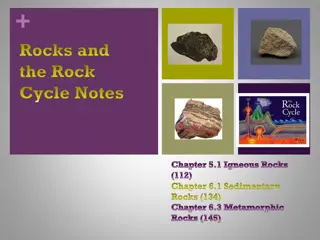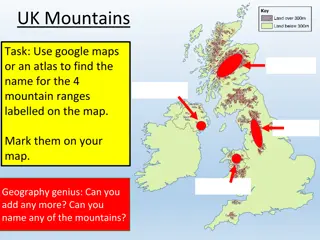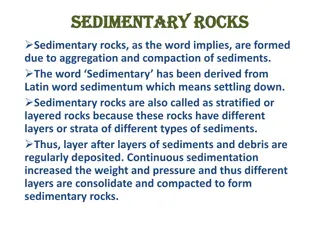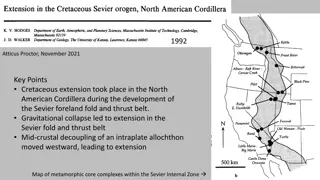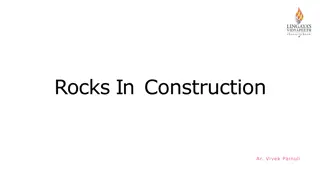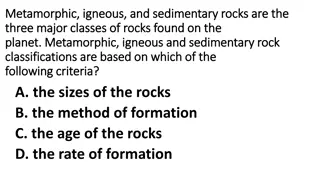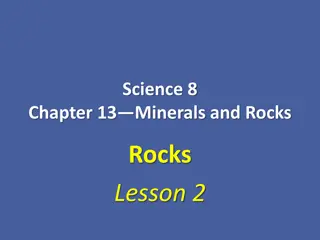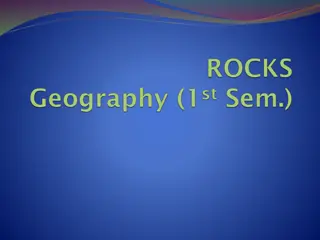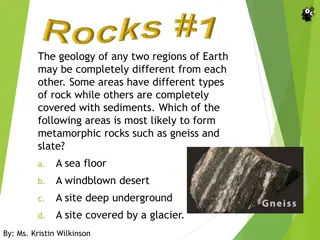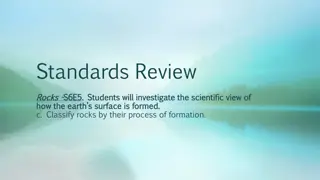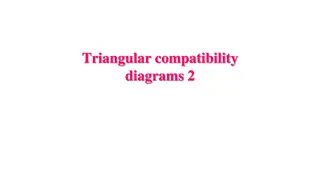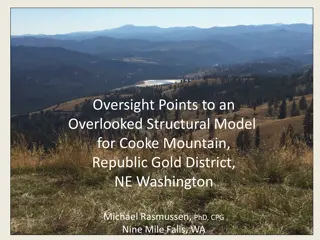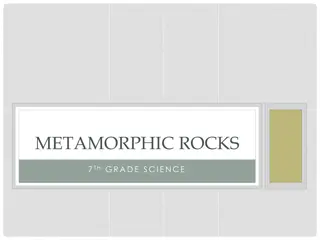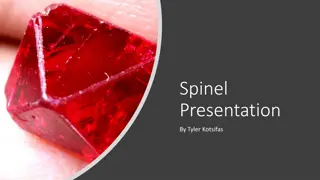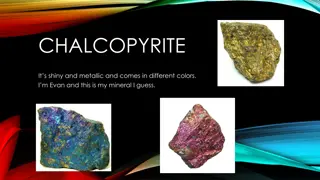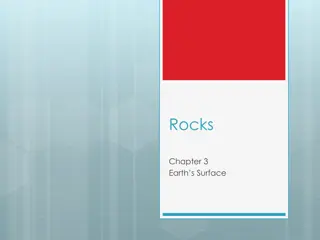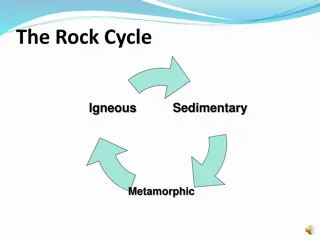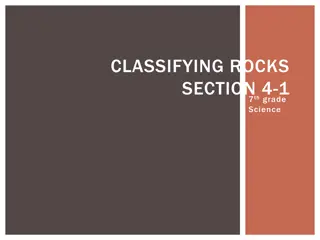Understanding the Rock Cycle: Igneous, Sedimentary, and Metamorphic Rocks
This educational material covers the formation and characteristics of Igneous, Sedimentary, and Metamorphic rocks. It includes details on the processes involved, such as heat melting rocks into magma, sediment formation through erosion and deposition, and the differentiation between intrusive and ex
1 views • 16 slides
Exploring UK Mountains and Rock Formations: A Geographical Journey
Uncover the mysteries of UK mountains and rock formations through a fascinating exploration of mountain ranges, such as the Grampian Mountains and Pennines, and various rock types like Sedimentary, Igneous, and Metamorphic. Discover how the geological landscape is shaped by the type of rock present
1 views • 13 slides
Formation and Characteristics of Sedimentary and Metamorphic Rocks
Sedimentary rocks are formed through the aggregation and compaction of sediments, while metamorphic rocks result from changes in the form or composition of existing rocks. Sedimentary rocks contain layers of different sediments and are abundant on Earth's surface, while metamorphic rocks undergo met
0 views • 7 slides
Evolution of Sevier Orogeny and Cretaceous Extension in North American Cordillera
The Sevier Orogeny in the Cretaceous period led to extension in the North American Cordillera, with gravitational collapse playing a key role in the development of the Sevier fold and thrust belt. The internal zone consisted of metamorphic core complexes and Mesozoic-Paleogene plutons, showcasing ev
0 views • 5 slides
Importance of Rocks in Construction and Building Materials
Rocks play a crucial role in construction as geological materials for foundations and building structures. They are classified into igneous, sedimentary, and metamorphic categories based on their composition and properties. Traditional stone masonry is being replaced by modern techniques like stone
1 views • 15 slides
Understanding Rocks: Types, Formation, and Properties
Rocks can be classified as metamorphic, igneous, or sedimentary based on their formation processes. Florida's phosphate deposits and pumice formation showcase the diversity of rocks. A scientist's rock cycle model helps predict changes, while pressure on sediments leads to new rock formation. Basalt
1 views • 22 slides
Understanding Metamorphic Rocks: Foliated vs. Nonfoliated
Explore the characteristics of metamorphic rocks through identifying whether they are foliated or nonfoliated and determining their parent rocks. Learn about rocks like gneiss, marble, and slate, and understand concepts such as loose rock grains being called sediment.
1 views • 16 slides
Understanding Different Types of Rocks and How They Form
Rocks are essential components of Earth's crust, consisting of various minerals held together by natural cement. They can be categorized into three groups: Igneous, Sedimentary, and Metamorphic rocks. Each group is formed differently, either through volcanic activity, sedimentation, or existing rock
3 views • 16 slides
Understanding Rocks and Minerals: Types and Formation
Rocks and minerals are natural substances with distinct characteristics. Rocks are solid aggregates of minerals or mineraloids, while minerals are naturally occurring chemical compounds. There are three main types of rocks: igneous, sedimentary, and metamorphic, each formed through different process
0 views • 16 slides
Understanding Earth's Geology and Rock Formation
Earth's geology varies across regions, with distinct rock types like metamorphic rocks found in particular environments. Learn about the characteristics of rocks, the properties of different rock types, and the impact of human activities on the rock cycle.
0 views • 7 slides
Understanding Rocks: Types, Formation, and Importance in Geology
Rocks are solid accumulations of minerals found in the Earth's lithosphere. They are classified into igneous, sedimentary, and metamorphic types based on their mineral composition. Rocks play a crucial role as geological materials for construction and historical buildings. Learn about the properties
0 views • 31 slides
Geology Test Review: Rocks and Minerals
This review covers the identification of rocks as igneous, sedimentary, or metamorphic, along with definitions and properties of minerals like cleavage, crystal structure, streak color, and more. It also discusses the classification of rocks as foliated or nonfoliated. Prepare for your geology test
2 views • 112 slides
Exploring Rocks: A 7th Grade Science Book on the Rock Cycle
Dive into the world of rocks with this comprehensive 7th-grade science book. Learn about the different types of rocks - igneous, metamorphic, and sedimentary. Explore how rocks are formed and categorized, and discover the processes that shape our Earth's rocky landscapes. Engage in hands-on activiti
0 views • 24 slides
Understanding Rock Formation and the Rock Cycle
Explore how the Earth's surface is formed through the classification of rocks based on their processes of formation. Learn about different rock types such as igneous, sedimentary, and metamorphic rocks, and understand concepts like the rock cycle and the effects of pressure on sedimentary rocks.
0 views • 13 slides
Petrology Diagrams and Projections in Mineralogy Studies
Explore a series of diagrams illustrating mineralogical concepts such as compatibility, solid solutions, and phase projections in petrology and metamorphic petrology studies. These visuals cover various systems and paragenesis examples, providing insights into the behavior of elements like Fe and Mg
0 views • 22 slides
Structural Model for Cooke Mountain in Republic Gold District, NE Washington
This article presents an overlooked structural model for Cooke Mountain in the Republic Gold District of NE Washington. It covers various geological aspects such as the Quesnel Terrane, growth of metamorphic core complexes, and the geology of the Republic, WA area. Detailed descriptions and images o
0 views • 19 slides
Metamorphic Rocks Hand Specimen Laboratory Analysis
Explore a comprehensive laboratory examination of various metamorphic rock hand specimens, identifying types of metamorphism, mineral compositions, textures, and formation conditions. Utilize images for visual aid and delve into metamorphic processes and rock characteristics.
0 views • 4 slides
Understanding Pyroxene Group in Geology: Composition and Significance
Pyroxenes are vital rock-forming minerals found in various types of igneous rocks and metamorphic conditions. They consist of linked SiO4 tetrahedra, forming structural chains with specific chemical compositions. The orthorhombic and monoclinic pyroxenes play essential roles in geology, demonstratin
0 views • 15 slides
Understanding Metamorphic Rocks in 7th Grade Science
Metamorphic rocks are formed deep beneath the Earth's surface through heat and pressure, leading to changes in the rock's structure. Geologists classify these rocks based on grain arrangement into foliated (layered) and nonfoliated (random). Examples include slate, schist, gneiss, marble, and quartz
0 views • 6 slides
Exploring the Fascinating World of Spinel: Properties, Classification, and Fun Facts
Uncover the beauty and intrigue of spinel, a metamorphic mineral with a rich history of being mistaken for rubies and sapphires. Learn about its chemistry, physical properties, classification in the isometric system, and isotropic nature. Delve into the fun facts surrounding spinel, including its va
0 views • 10 slides
All About Chalcopyrite: A Shiny Metallic Mineral
Shiny and metallic, chalcopyrite is a mineral that comes in various colors, with a brass-yellow appearance and often an iridescent tarnish. Forming in igneous and metamorphic rocks, it is commonly found alongside other copper sulfide minerals. Chalcopyrite is a primary ore mined for copper, known fo
0 views • 7 slides
Understanding Rocks and the Rock Cycle
Explore the world of rocks through this educational content on Earth's surface, rock cycle, rock types (igneous, sedimentary, metamorphic), and the formation of igneous rocks from magma and lava. Learn how rocks are made of minerals, the continuous process of the rock cycle, and the classification o
0 views • 29 slides
Understanding the Rock Cycle Process
Exploring the rock cycle, which involves the formation, transformation, and breakdown of rocks into three main types: sedimentary, igneous, and metamorphic. Learn about how rocks change through processes like heat, pressure, erosion, and melting.
0 views • 9 slides
Understanding Rock Classification in 7th Grade Science
When studying rocks, scientists analyze their mineral composition, color, and texture. Rock-forming minerals play a significant role in Earth's geology, with granite and basalt being prime examples. The texture of rocks is determined by the size, shape, and pattern of grains present. Rocks form thro
0 views • 9 slides
